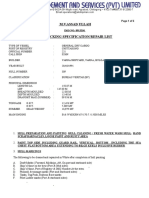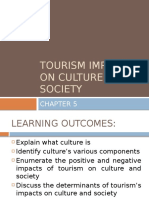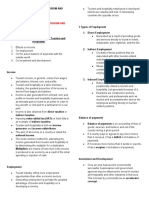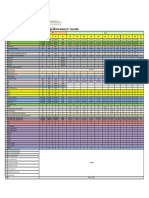100%(1)100% found this document useful (1 vote)
3K viewsChapter 4
Chapter 4
Uploaded by
Agee Kaina GironTransportation has evolved over seven eras from pre-industrial to post-mobility. Early systems had little regular travel but industrialization brought common carriers by rail, canal, and steamship. Railways expanded in the mature railway era. Express services increased speed in the express travel era. The automobile became predominant in the automobile-based travel era. Wide jets and mass tourism dominated the modern tourism era. The oil crisis changed travel patterns to alternative modes in the post-mobility era.
Copyright:
© All Rights Reserved
Available Formats
Download as PPTX, PDF, TXT or read online from Scribd
Chapter 4
Chapter 4
Uploaded by
Agee Kaina Giron100%(1)100% found this document useful (1 vote)
3K views43 pagesTransportation has evolved over seven eras from pre-industrial to post-mobility. Early systems had little regular travel but industrialization brought common carriers by rail, canal, and steamship. Railways expanded in the mature railway era. Express services increased speed in the express travel era. The automobile became predominant in the automobile-based travel era. Wide jets and mass tourism dominated the modern tourism era. The oil crisis changed travel patterns to alternative modes in the post-mobility era.
Original Title
chapter-4.pptx
Copyright
© © All Rights Reserved
Available Formats
PPTX, PDF, TXT or read online from Scribd
Share this document
Did you find this document useful?
Is this content inappropriate?
Transportation has evolved over seven eras from pre-industrial to post-mobility. Early systems had little regular travel but industrialization brought common carriers by rail, canal, and steamship. Railways expanded in the mature railway era. Express services increased speed in the express travel era. The automobile became predominant in the automobile-based travel era. Wide jets and mass tourism dominated the modern tourism era. The oil crisis changed travel patterns to alternative modes in the post-mobility era.
Copyright:
© All Rights Reserved
Available Formats
Download as PPTX, PDF, TXT or read online from Scribd
Download as pptx, pdf, or txt
100%(1)100% found this document useful (1 vote)
3K views43 pagesChapter 4
Chapter 4
Uploaded by
Agee Kaina GironTransportation has evolved over seven eras from pre-industrial to post-mobility. Early systems had little regular travel but industrialization brought common carriers by rail, canal, and steamship. Railways expanded in the mature railway era. Express services increased speed in the express travel era. The automobile became predominant in the automobile-based travel era. Wide jets and mass tourism dominated the modern tourism era. The oil crisis changed travel patterns to alternative modes in the post-mobility era.
Copyright:
© All Rights Reserved
Available Formats
Download as PPTX, PDF, TXT or read online from Scribd
Download as pptx, pdf, or txt
You are on page 1of 43
CHAPTER 4 Transportation Sector
TRANSPORTATION AND TRAVEL EVOLUTION
Transportation and travel have undergone many changes. The evolution of
transportation and travel took seven eras such as:
•Pre-industrial travel system era
•Early industrial travel system era
•Mature railway system era
•Express travel system era
•Automobile-based travel system era
•Modern-tourism travel system era
•Post-mobility adjustment era
PRE-INDUSTRIAL TRAVEL SYSTEM ERA
•This was the period before the
widespread industrialization in Europe
and North America.
•There were almost no regularly
scheduled transportation services.
•There was little travel.
•Only few people had the money and the
reason to travel.
EARLY INDUSTRIAL TRAVEL SYSTEM ERA
•This era was when road improvements
such as railways, canals and steamship
services were brought about due to
rapid industrialization and advances in
transportation technology.
• Common carriers came into existence
and started offering regularly scheduled
transportation services.
•Travel increased because more people
who had money traveled.
MATURE RAILWAY SYSTEM ERA
•This was characterized by railways which
expanded their operations by running
hotels and providing other travel-related
services.
• Travel agencies and tour companies
were formed.
•Thomas Cook, an innovator in this field
during this era, began his company’s
activities in the United Kingdom in 1840.
•More people traveled.
EXPRESS TRAVEL SYSTEM ERA
•Express services increased.
•Trains and other forms of transportation
stopped at major stations or terminals.
•This increased the speed of travel and
encouraged more travel than before.
AUTOMOBILE-BASED TRAVEL SYSTEM ERA
•Car ownership boomed in North
America.
• Motorways, interstate highways, and
other trunk highways were developed in
the latter half of this era from 1920 to
1974.
•The automobile was predominant over
other travel modes from 1920 to 1945.
MODERN-TOURISM TRAVEL SYSTEM ERA
•The period from 1945-1974 is also
known as the “modern tourism travel
system era.”
•Car ownership continued to grow at a
fast rate, mainly at the expense of long-
distance rail travel.
• The introduction of wide bodied jets in
1970 greatly increased air travel.
•“Mass tourism” philosophy and
marketing approaches were dominant
during the 1950s and 1960s.
POST-MOBILITY ADJUSTMENT ERA
•This era was began in 1973-1974 as a
result of the oil embargo generated by
the Organization of Petroleum Exporting
Countries (OPEC) and the resulting
increase in fuel prices.
•The events of the energy crisis basically
changed the travel patterns throughout
the world.
•The present era is one in which travelers
continue to look to alternative, group-
oriented modes of transportation.
HISTORICAL DEVELOPMENT OF THE TRANSPORT
SYSTEM
The desire to travel began with the improvement of transportation.
Pre-World War I – seven days travel by steam locomotive to go from coast to coast
By 1950 – travellers could complete the journey in to and a half days by train.
In 1938 – an airplane with the speed of 400 miles an hour made possible nonstop
coast-to-coast flights within less than 8 hours.
In 1950 – travel time from coast to coast decreased to just four hours.
At present, the Concorde can fly for two and a half hours.
The table in the following slides shows the Historical Development of the Transport
System:
HISTORICAL DEVELOPMENT OF THE TRANSPORT
SYSTEM
Year Mode of Transport Speed (miles per hour)
6000 BC Camel caravan 8
1600 BC Chariot 20
AD 1784 First English mail coach 10
1825 First steam locomotive 13
1890 Improved steam locomotive 100
Land speed record
1931 (Bluebird: Sir Malcolm 350
Campbell)
Land speed record
1938 (Napier-Railton car: John 350
Cobb)
HISTORICAL DEVELOPMENT OF THE TRANSPORT
SYSTEM
Year Mode of Transport Speed (miles per hour)
1938 Piston aircraft 400
United States liner form
1952 41
New York to Le Harve
1958 Jet fighter air 1,300
Boeing 707 and DC-8
1958 600
aircraft
Spaceship (Vostok 1
1961 17,560
orbiting)
1967 Rocket plane 4,534
1970 Fighter bomber (Mirage IV) 1,450
Commercial aircraft:
1970 1,320
Concorde
1970 Boeing 747 626
HISTORICAL DEVELOPMENT OF THE TRANSPORT
SYSTEM
The development in transportation has
made the world a smaller place. Now it’s
possible to take one to two weeks of
vacation in distant places such as Europe,
the United States, the Caribbean,
Mexico, and South America, thanks to the
fast and efficient means of
transportation.
SELECTION OF TRANSPORTATION MODE
People select one transportation mode over another for their
business and pleasure tips because of:
Cost
traveling time
Safety
convenience
Comfort
availability
frequency of trips
ground services
terminal facilities & locations
status & prestige, and
departure & arrival times.
IDENTIFYING TRANSPORTATION VARIABLES
Travelers, according to Jagdish Sheth,
choose a travel mode based on how they
psychologically weight five factors such
as:
Functional
Aesthetic/emotional
Social/organizational
Situational
Curiosity
TRAVEL BY TRAIN
Train travel started within the United
States, Canada and Europe in the 19th
and early 20th centuries. Britain had its
first organized train tour in 1841 when
Thomas Cook organized an excursion
between Leicester and Loughborough.
The first transcontinental route in the
United States was completed in 1869.
Travel by train became the primary
means of movement within such country
from 1895 until after World War II
TRAVEL BY TRAIN
In 1863, long-distance rail travel
boosted when George M. Pullman built
the Pullman coach, a luxury first-class
sleeping and dining facility. In 1868, the
diner car was introduced on the Chicago
and Alton line.
After World War II, the popularity of
the train lasted only shortly when the
automobile began to gain more
popularity as a passenger transportation
mode.
WHY TRAVELERS SELECT THE TRAIN AS A
TRANSPORTATION MODE
Cost/price
Comfort
Safety
Ability to see the area whwhere the train
is passing.
TRAVELERS FAVOURED THE TRAIN FOR THE
FOLLOWING REASONS (AMTRAK SURVEY)
Safety
Ability to look out of the train and see
the interesting things en route
Ability to get up and walk around
Arriving at the destination rested and
relaxed
Personal comfort
NEGATIVE FACTORS OF RAIL TRAVELERS
Slowness in reaching the destination
Inflexible departure time
Lack of Quality in Food Services
TRAIN TRAVEL OUTSIDE THE UNITED STATES
Train travel has continued in Europe and
Asia more than in the United States for
long-distance travel. The Euro City
network, formerly the Trans Europe
Express (TEE) Network, and other
national lines provided excellent rail
services between major cities in 10
countries.
TRÈS GRAND VITESSE
The popularity of the train system in
Europe has increased because of its
quality and efficiency, as well as the use
of the Eurailpass. Many European
countries introduced the Eurailpass in
1939 which allowed a traveller to use it
for two months of unlimited second-class
travel on any of the rail systems of the
European countries.
TRAVEL BY SHIP
Whereas travel by ship preceded travel
by train, travel by ocean liners became
prominent in the middle of the 19th
century. These were used to provide an
important link to passengers among
continents.
The steamship era began in 1840 when
Sir Samuel Cunard pioneered the first
transatlantic-scheduled liner ups.
CRUISE SHIP
Cruises are more of a vacation mode
than transportation mode. These are
divided into three types:
Short cruise – one week or less
Intermediate long cruises – one to four
weeks
Long cruises – go around the world for
one to three months.
CRUISE SHIP
A cruise ship is both a floating hotel and
resort because the guests are housed,
fed and entertained. They also provide
continuous entertainment such as charm
classes, language lessons, dance classes,
bridge, table tennis, aerobics, jogging
and shuffleboard.
CRUISE SHIP
Cruises are promoted and sold on the
basis of health, recreation and pleasure.
The United States dominates the
international cruise market by supplying
more than 70% of total passengers,
followed by Europe with 17%.
CARIBBEAN CRUISE SHIP
Caribbean is the world’s largest cruise
destination Cruise passengers within the
Caribbean comprise 50% of total visitor
arrivals. Cruises are announced several
months before the departure and are
also so mostly by travel agents as
packages.
FERRY BOATS
Ferry boats are used in the English
Channel, the Irish Sea, the Hebridean
Islands of Scotland, the North Sea, the
Maritime provinces and British
Columbian coast in Canada, and on the
Grade Lakes.
TRAVEL BY AUTOMOBILE
Carl Benz of Mannheim, Germany,
invented the automobile in 1885-1886.
He combined the bicycle and the
international combustion engine and
designed the complete vehicle engine
consisting of the engine, chassis and
transmission.
TRAVEL BY AUTOMOBILE
Henry Ford produced the Model T car in
1908, build with an assembly technique
for mass production. Its price decreased
from $825 in 1908 to $260 in 1925.
TRAVEL BY AUTOMOBILE
Automobile became popular after
World War II. When it was introduced, it
brought about the decline of the train’s
popularity in most developed countries.
Traveling by automobile is now the chief
travel mode in North America. In many
travel surveys, automobile trips comprise
90% or more of the pleasure/personal
and business trips of most Canadians
and Americans.
CAR RENTAL BUSINESS
The car rental business is a worldwide
industry. There are companies called the
“Big 4” when it comes to this business in
the US, such as:
Hertz
Avis
Budget
National
Some car rental firms have added
cellular car telephones for business
travellers.
TRAVEL BY BUS/MOTOR COACH
This type of travel is the most flexible
and economical mode of transportation.
The terms “bus”, “coach” and “motor
coach” are used interchangeably.
Bus travel is selected mainly because of
convenience and economy. Few people
choose the bus for business travel.
BUS CHARTER AND TOUR SERVICE
Charter and tour service is the fastest
growing segment of the bus or motor
coach industry. Several tour packages
are developed by tour brokers who
charter buses and arrange all the other
components of the tour.
TRAVEL BY AIR
The history of air transportation can be
divided into three parts:
Pre-World War II – almost all early
airlines started by carrying mail for the
post office;
World War II – influenced the
development of the airline industry; and
Post-World War II – when commercial jet
aircrafts were introduce.
BOEING 747
A long-haul plane, the Boeing 747
stands 63 feet and 5 inches tall, about
as high as a five-storey building. It
weights 775,000 pounds and cruises at
625 miles per hour, with some models
having a range of 6,210 miles without
refuelling.
CHARTER SERVICES
Charter services are an alternative to
regularly scheduled services. They offer
low rates for two reasons:
They don’t have the large personnel
investment required an airline with
regularly settled flights
By flying with a full load of passengers,
the charter companies are able to fly
their plans for less cost per passenger.
EIGHT FREEDOMS OF THE AIR
First Freedom – the right of an airline to
overfly one country to get to another
Second Freedom – the right of an airline
to land in another country for a technical
stopover (fuel, maintenance, etc) but
does not pick up or drop off traffic;
EIGHT FREEDOMS OF THE AIR
Third Freedom – the right of an airline,
registered in country X, to drop off
traffic from country X to country Y;
Fourth Freedom – The right of an airline,
registered in country X, to carry traffic
back to country X from country Y;
EIGHT FREEDOMS OF THE AIR
Fifth freedom – The right of an airline,
registered in country X, to collect traffic
in country Y and fly on to country Z, so
long as the flight either originates or
terminates in country X;
Sixth freedom – the right of an airline,
registered in country X, to carry traffic
to a gateway – a point in country X –
and then abroad. The traffic has neither
its origin nor ultimate destination in
country X;
EIGHT FREEDOMS OF THE AIR
Seventh freedom – the right of an
airline, registered in country X, to
operate entirely outside of country X in
carrying traffic between two other
countries and
Eighth freedom – the right of an airline,
registered in country X, to carry traffic
between any two points in the same
foreign country; also known as
cabotage.
BILATERAL AIR AGREEMENT
Bilateral agreements were established to
provide for the orderly development of
the international air transportation
industry. There was more need for
bilateral agreements because small
nations felt that they should have their
own national airline or flag carrier.
Thank you
for listening!
You might also like
- Module 1. Intro To Tourism Transpo MGMT (Transportation Management) - TMPC 111Document7 pagesModule 1. Intro To Tourism Transpo MGMT (Transportation Management) - TMPC 111Maritoni Medalla100% (6)
- Chapter 10 Current Trends and Issues in The Tourism and Hospitality IndustryDocument14 pagesChapter 10 Current Trends and Issues in The Tourism and Hospitality IndustryJoshua Cajulao Yasay67% (18)
- The Social Nature of TravelDocument6 pagesThe Social Nature of TravelAdrian WayanNo ratings yet
- Dry-Dock Repair ListDocument6 pagesDry-Dock Repair ListAnwarul Islam100% (5)
- Legal Aspects Module 4Document8 pagesLegal Aspects Module 4John AlingodNo ratings yet
- CH 2 History of TourismDocument32 pagesCH 2 History of TourismJM Mejia100% (3)
- The Tourism and Hospitality Network and Supply ComponentsDocument18 pagesThe Tourism and Hospitality Network and Supply ComponentsLiza Mary100% (1)
- Chapter 5Document2 pagesChapter 5Kenneth Masiclat100% (2)
- Tourism Transportation Management (Prelim) I. IntroductionDocument23 pagesTourism Transportation Management (Prelim) I. IntroductionMaritoni Medalla100% (7)
- Discovery Shores Boracay - Marketign PlanDocument20 pagesDiscovery Shores Boracay - Marketign PlanCeddie UnggayNo ratings yet
- Cultural Factors With Tourist AppealDocument2 pagesCultural Factors With Tourist AppealDreiBadua74% (43)
- Module 4 TRANSPORTATION SECTORDocument17 pagesModule 4 TRANSPORTATION SECTORCarl Anthony P. PilapilNo ratings yet
- Transportation ServicesDocument16 pagesTransportation ServicesCharming Dabandan100% (2)
- Ch. 4 - Micro Perspective of The Tourism and HospitalityDocument20 pagesCh. 4 - Micro Perspective of The Tourism and HospitalityFrancine BalansagNo ratings yet
- Transportation SectorDocument23 pagesTransportation SectorJulieSanchezErsandoNo ratings yet
- Chapter-5 - Tourism and Hospitality OrganizationDocument26 pagesChapter-5 - Tourism and Hospitality OrganizationJanel Manalastas BunyiNo ratings yet
- Macro Perspective Prelim ModuleDocument8 pagesMacro Perspective Prelim ModuleJaz JusiNo ratings yet
- Module 2. Air Transportation (Transportation Management) - TMPC 111Document9 pagesModule 2. Air Transportation (Transportation Management) - TMPC 111Maritoni Medalla100% (1)
- Ch. 5 - Micro Perspective of The Tourism and HospitalityDocument24 pagesCh. 5 - Micro Perspective of The Tourism and HospitalityFrancine BalansagNo ratings yet
- Components of Tourism and Hospitality - Lesson 1Document2 pagesComponents of Tourism and Hospitality - Lesson 1Jan Jan100% (3)
- The Rise of New Travel PatternsDocument12 pagesThe Rise of New Travel PatternsClarita ArañezNo ratings yet
- Chapter 6 The Impacts of Tourism and HospitalityDocument15 pagesChapter 6 The Impacts of Tourism and HospitalityGrethel Heart DejerioNo ratings yet
- Chapter 5 - Tourism Impacts On Culture and SocietyDocument23 pagesChapter 5 - Tourism Impacts On Culture and Societyanon_16301208No ratings yet
- Macro Perspective of Tourism and Hospitality Finals ReviewerDocument4 pagesMacro Perspective of Tourism and Hospitality Finals Reviewershaira balitaanNo ratings yet
- Tourism Supply ComponentsDocument14 pagesTourism Supply ComponentsMichael Jr ZeuqirneNo ratings yet
- TOURISM AND HOSPITALITY ORGANIZATIONS Di Pa TapooosDocument97 pagesTOURISM AND HOSPITALITY ORGANIZATIONS Di Pa TapooosDianne EvangelistaNo ratings yet
- Chapter 13 Tourism PlanningDocument18 pagesChapter 13 Tourism PlanningSharlyne PimentelNo ratings yet
- TM 111 - Module 4 - The Tourism and Hospitality Network and Supply ComponentsDocument14 pagesTM 111 - Module 4 - The Tourism and Hospitality Network and Supply ComponentsDaniel ZuniegaNo ratings yet
- Legal Aspects Module 3Document22 pagesLegal Aspects Module 3John AlingodNo ratings yet
- Chapter 9 MacroDocument11 pagesChapter 9 MacroRoy CabarlesNo ratings yet
- Module 3 MiceDocument54 pagesModule 3 MiceAlexandra ArzagaNo ratings yet
- Classification of TravelersDocument18 pagesClassification of TravelersCauseNo ratings yet
- Module 1 Week 1,2,3 & 4Document21 pagesModule 1 Week 1,2,3 & 4Rosie Mae Villa - NacionalesNo ratings yet
- The Hospitality and Tourism Industry ContextDocument42 pagesThe Hospitality and Tourism Industry ContextLouchelle Cacatihan100% (2)
- Sta. Ana, Erica Mae SD. 2018006871 Learning Activities No. 1Document12 pagesSta. Ana, Erica Mae SD. 2018006871 Learning Activities No. 1Erica Sta Ana0% (1)
- Module 5 LeisuresrmDocument28 pagesModule 5 LeisuresrmJann Rey ReclaNo ratings yet
- Chapter 5 Mice ManagementDocument44 pagesChapter 5 Mice ManagementJE JE GAGATAM100% (1)
- Identify The Meaning and Describe The Mandate, Functions, and Compositions of The Following Tourism OrganizationsDocument8 pagesIdentify The Meaning and Describe The Mandate, Functions, and Compositions of The Following Tourism OrganizationsAngelica IlaganNo ratings yet
- THM07 Module 11 Destination Branding and MarketingDocument14 pagesTHM07 Module 11 Destination Branding and Marketingjennifer miranda100% (2)
- Sustainable Tourism: TMPC 0313Document49 pagesSustainable Tourism: TMPC 0313Jomer Sidon BalgosNo ratings yet
- Chapter 5 - Homestay OperationsDocument9 pagesChapter 5 - Homestay OperationsChristine PisueñaNo ratings yet
- CHPTR 5 Tourism Planning Garcia Dela CruzDocument27 pagesCHPTR 5 Tourism Planning Garcia Dela CruzLester MojadoNo ratings yet
- Chapter 12 Tourism Distribution ChannelDocument16 pagesChapter 12 Tourism Distribution ChannelSharlyne PimentelNo ratings yet
- Micro Perspective in T&HDocument7 pagesMicro Perspective in T&HPransis MayobdobNo ratings yet
- AUREOUS11Document3 pagesAUREOUS11JoshTVNo ratings yet
- Module 002: The Meaning and Classification of Tour GuideDocument4 pagesModule 002: The Meaning and Classification of Tour GuideEve Fajardo-Sanchez100% (1)
- Script For Tour GuidingDocument2 pagesScript For Tour GuidingLindsey CruzNo ratings yet
- THC 115 - Module For Week No. 7Document16 pagesTHC 115 - Module For Week No. 7Tea cherNo ratings yet
- Tourism and Hospitality OrganizationsDocument54 pagesTourism and Hospitality OrganizationsDianne EvangelistaNo ratings yet
- Tour and Travel ManagementDocument8 pagesTour and Travel ManagementNicole SarmientoNo ratings yet
- The Impacts of Tourism and HospitalityDocument15 pagesThe Impacts of Tourism and Hospitalitysuby100% (2)
- Chapter 5 MacroDocument26 pagesChapter 5 MacroKaren M.100% (8)
- Module 2 Lesson 2 Ecotourism FacilitiesDocument3 pagesModule 2 Lesson 2 Ecotourism FacilitiesJohn Ariel Labnao GelbolingoNo ratings yet
- Chapetr 6Document3 pagesChapetr 6Kenneth MasiclatNo ratings yet
- THM07 Module 4 Tourism Marketing and The Communication ProcessDocument13 pagesTHM07 Module 4 Tourism Marketing and The Communication Processjennifer miranda100% (1)
- Chapter 1 Overview of Tourism and Hospitality IndustryDocument8 pagesChapter 1 Overview of Tourism and Hospitality IndustryJ Xio Thonzky Cabbigat100% (1)
- Tour Guiding ScriptDocument5 pagesTour Guiding ScriptArjay SolisNo ratings yet
- Ch. 6 - Micro Perspective of The Tourism and HospitalityDocument14 pagesCh. 6 - Micro Perspective of The Tourism and HospitalityFrancine BalansagNo ratings yet
- Module-4-6 Hospitality ManagementDocument28 pagesModule-4-6 Hospitality ManagementShaira A. SampagaNo ratings yet
- Chapter 4 - Transportation SectorDocument20 pagesChapter 4 - Transportation SectorBernyl Grace Dormitorio - PanaguitonNo ratings yet
- TransportationDocument17 pagesTransportationMikayah g.No ratings yet
- INS Kursura (S20) - WikipediaDocument34 pagesINS Kursura (S20) - Wikipediajohirmondal872No ratings yet
- 2020 PacNW Checklist Rev 1Document5 pages2020 PacNW Checklist Rev 1DeepakpanarkandyNo ratings yet
- Tautwire MK 15BDocument38 pagesTautwire MK 15BValentin JonovNo ratings yet
- Information Bulletin No. 171: Control and Management of Ships' BiofoulingDocument5 pagesInformation Bulletin No. 171: Control and Management of Ships' BiofoulingRamson RaymondNo ratings yet
- Comments On Type XXI UDocument9 pagesComments On Type XXI UmitchtanzNo ratings yet
- IOPP + Form RDocument8 pagesIOPP + Form RWILLINTON HINOJOSANo ratings yet
- Ophelia Deck PlansDocument2 pagesOphelia Deck PlansVictoria MillerNo ratings yet
- Ship Design For Efficiency and Economy-7-226-25-32Document8 pagesShip Design For Efficiency and Economy-7-226-25-32galin8575No ratings yet
- Passage PlanningDocument5 pagesPassage PlanningResian Garalde Bisco100% (2)
- Equipment Sheet: Trailing Suction Hopper DredgerDocument2 pagesEquipment Sheet: Trailing Suction Hopper DredgerGede Putra100% (1)
- Semi Submersible Heavy Lift VesselDocument12 pagesSemi Submersible Heavy Lift VesselmailokeNo ratings yet
- ABS VER Question Choice A Choice B Choic PDFDocument270 pagesABS VER Question Choice A Choice B Choic PDFnikolai_roNo ratings yet
- Proship - Apapa - c134 RFDocument1 pageProship - Apapa - c134 RFVISHNU GOWARINo ratings yet
- Saipem 3000Document8 pagesSaipem 3000del3333No ratings yet
- Msact - 2002 (1) AmmendmentsDocument47 pagesMsact - 2002 (1) AmmendmentsseaguyinNo ratings yet
- Line Way BillDocument2 pagesLine Way Billamekheimar1975No ratings yet
- Principles of Naval Architecture Vol I - Stability and Strength PDFDocument316 pagesPrinciples of Naval Architecture Vol I - Stability and Strength PDFmustain_henyNo ratings yet
- Shibata CP - Old CatalogDocument64 pagesShibata CP - Old CatalogRafael Tavares Silva100% (1)
- Offshore Production FacilitiesDocument8 pagesOffshore Production FacilitiesPercival Wulfric Brian100% (1)
- ARTICLE 586. The Shipowner and The Ship Agent Shall Be Civilly Liable ForDocument20 pagesARTICLE 586. The Shipowner and The Ship Agent Shall Be Civilly Liable ForShasharu Fei-fei LimNo ratings yet
- Poe - Ms Found in A BottleDocument9 pagesPoe - Ms Found in A BottleMauricio Sosa SantibáñezNo ratings yet
- Orals Question FUNCTION 2Document18 pagesOrals Question FUNCTION 2Shivendra Pratap Singh100% (1)
- Transportation Law Reviewer SAN BEDADocument43 pagesTransportation Law Reviewer SAN BEDAKathea BollozosNo ratings yet
- Maritime Course Dates and Availibility Glasgow Maritime AcademyDocument1 pageMaritime Course Dates and Availibility Glasgow Maritime AcademyVinil Gupta100% (2)
- Ship - Structural - Design 1 FACULDADE ALEXANDRIA PDFDocument122 pagesShip - Structural - Design 1 FACULDADE ALEXANDRIA PDFEDEN SARMENTONo ratings yet
- AE SpecificationDocument9 pagesAE SpecificationRusuVasileCristianNo ratings yet
- The Sloop's Log Fall 2011Document16 pagesThe Sloop's Log Fall 2011Chebeague Island Historical SocietyNo ratings yet
- US 047F - Exercise Checklist 2024 Rev 0Document11 pagesUS 047F - Exercise Checklist 2024 Rev 0fsbv7fx9No ratings yet
- Engine Room Simulator BrochureDocument8 pagesEngine Room Simulator BrochureVann Harold de GuzmanNo ratings yet

























































































